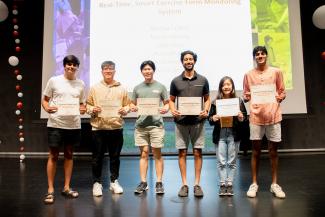
Texas ECE announced the winning teams from the Spring 2022 Capstone Design Showcase at Celebrate ECE on Tuesday, April 25, 2023.
The Capstone Design Showcase winning teams are:
FIRST PLACE • INDUSTRY CATEGORY
Rust Programming for Robotics
Rust is a Hardware Abstraction Layer (HAL) for the use of the Rust programming language in robotics applications on the Texas Instruments MSP430 series. This HAL allows developers to interface with the MSP430’s hardware more efficiently and in a more intuitive manner. Rust has multiple unique features that make it suited to embedded programming, including an emphasis on memory safety and easy package management with Cargo. We have further developed an existing, incomplete HAL for the MSP430 series to the point where we are able to demo live Rust code on the TI-RSLK robotics kit and TI-BOOSTXL booster board.
Team Members
Allen Jiang, Massad Khan, Ryan McSweeney, Alec Neiman, John Wright
Faculty Partner
Texas Instruments
Faculty Mentor
Prof. Jean Anne Incorvia
FIRST PLACE • INDUSTRY CATEGORY
BreakerBot 2.0
When a breaker trips in the nacelle of a wind turbine, there are significant opportunity and labor costs associated with dispatching a technician to manually reset it. Our project aims to reduce these costs by creating a BreakerBot which is able to monitor breaker status and perform a reset action remotely.
Team Members
Mariano Blanco, William Bundrant, Kyle Dotter, Ahmad ElBanhawy, Christopher Morton, Chet Pena
Faculty Partner
RWE Renewables Americas, LLC
Faculty Mentor
Prof. Jaydeep Kulkarni
FIRST PLACE • HONORS CATEGORY
Miniature Implantable Trimodal Neural Interface Device
A neural-recording, headstage device wirelessly communicates signals from the brain of an animal subject to a data receiver using a bidirectional Bluetooth Low Energy (BLE) link. The headstage device can record either electrical or electrochemical signals and provides user-controlled optical stimuli to help probe brain tissues. The data receiver incorporates a graphical user interface (GUI) that can process and display data in real-time. The GUI also provides controls to configure the optical stimuli and to start/stop neural recording.
Team Members
Ravi Akalkotkar, Isha Chakraborty, Tristram Coffin, Xingjian Gan, Molly Hu, Daniel Krueger
Faculty Mentor
Prof. Yaoyao Jia
FIRST PLACE • HONORS CATEGORY
Real-Time, Smart Exercise-Form Monitoring System
Re:Form seeks to provide valuable and informational feedback to trainers and experienced athletes on an individual’s form during a particular movement. With the ability to provide information that is difficult to gauge from sight alone, Re:Form integrates data from an array of sensors and displays feedback on an iPhone application that allows the user to evaluate their form, crucial for further form improvements and injury risk reductions. Specifically, the current version of Re:Form has the capability to evaluate the form of two types of weight lifts, which it accomplishes through a computer vision-based model applied to a video captured by an iPhone camera, a Velostat-based pressure pad to measure the distribution of weight applied on the feet, and inertial measurement unit sensors placed on the barbell to track its movement. However, the applications of Re:Form extend beyond weightlifting - the phone application and biosensors can be used to help athletes in other disciplines, as well as those going through physical therapy and rehabilitation.
Team Members
Michael Chen, Tianda Huang, Udai Jain, Hannah Lee, Rishi Ponnekanti, Ishan Shah
Faculty Mentor
Prof. Seth Bank
